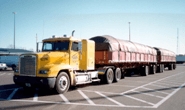Shipping and Logistics

Trucking Industry Copes with Coronavirus
Written by Sandy Williams
March 31, 2020
The COVID-19 crisis caused a spike in truck rates in March as vans and reefers worked to replenish retail stocks and move essential supplies. DAT Trendlines said rates are likely to fall in the coming weeks, however, as fewer load postings occur.
Van and reefer rates are expected to stay elevated, whereas flatbed rates and load-to-truck posts are likely to dip as infrastructure demand declines.
“The surge in volume from replenishment activities continues to drive up demand, as reflected in load-to-truck ratios (LTRs) and rates,” said DAT. “It will be important to study the impact this trend has when combined with an increase in imports, drayage, and inland movements, when backlogged freight begins to arrive in large volume from Southeast Asia.”
Transportation intelligence firm FTR forecasts overall truck loadings will decrease 4 percent this year versus their previous pre-crisis forecast of a 1.3 percent gain. Without support from an infrastructure bill, loadings for flatbed, bulk and dump segments are expected to decrease 6 to 9 percent.
“The hardest area it is going to hit is the industrial sector,” said Avery Vise, FTR’s vice president of trucking. “Flatbed is going to feel a whiplash because it was strengthening earlier due to housing starts and it is now going to be hit, at least in the near term, by a drop in housing starts, as well as what is going on with oil and a potential collapse in demand in the Permian Basin.”
Hours-of-service rules were suspended for drivers delivering essential supplies during the pandemic, resulting in longer hours on the road and waiting at loading docks. Drivers report difficulty finding places to rest due to shutdowns of service plazas, rest areas and fast food restaurants. Inadequate access to bathroom and shower facilities and lack of protective personal equipment has added to driver concerns about exposure to the virus.
One bright spot for drivers is the reduced traffic on the roads due to shelter-in-place regulations.
“ATRI’s real-time GPS data comes from more than a million trucks, allowing us to analyze freight flows, and so far in March what we are seeing is an unprecedented level of truck movement,” said American Trucking Associations COO Rebecca Brewster. “Not only are trucks continuing to move, but they are doing so at speeds well in excess of normal traffic patterns.”
Truck speeds have doubled in major cities as drivers no longer contend with bottlenecks on highways. Average speed in the New York Queens area has jumped to 38 mph from an average of 16 mph. Los Angeles speeds during morning rush hour, usually averaging less than 25 mph, are now whizzing by at 53 mph. A notorious bottleneck in Atlanta during the afternoon rush hour has jumped from an average of 15 mph to 53 mph.
“Spaghetti Junction [in Atlanta] is typical of what we’ve seen across the country, especially in areas hit hard by the virus and subject to quarantines and lockdowns,” Brewster said. “As other traffic dissipates, trucks continue to move, delivering much-needed relief supplies to markets, hospitals, gas stations and other essential businesses.”
ATRI says the increase in speed can be explained by the reduction in commuter traffic as well as the 24/7 truck operations in place during the pandemic.
“Normally, ATRI’s bottleneck data is used to show us where the problems are on our highway system,” said ATA President and CEO Chris Spear, “but during this period of extreme uncertainty, the data is showing us where the solution is — in the back of America’s trucks as professional drivers continue to quickly and safely deliver life-sustaining medical supplies, food, fuel and other essentials to Americans when they need it most.”

Sandy Williams
Read more from Sandy WilliamsLatest in Shipping and Logistics

US Great Lakes iron ore cargoes down notably through May
The Lake Carriers' Association reported a considerable decline in monthly iron ore shipments from US ports on the Great Lakes.

Wittbecker: West Coast port congestion
What's going on in West Coast ports?

Wittbecker: Mexico invests in port capacity despite US tariff troubles
The Mexican government aims to transform Manzanillo into the largest seaport in Latin America, capable of processing some 10 million TEU (20-foot equivalent units) per year by 2030. It is already Mexico's largest port and the third largest in Latin America, handling nearly 4 million 20-foot containers in 2024.

Wittbecker on Aluminum: When do the tariffs reach Main Street?
Containers sailing from China in April are down 15%-20% and Hapag Lloyd says their future bookings transpacific are down 30%.

Wittbecker on Aluminum: US-China trade war clobbers cross-Pacific trade
Container shipping lines have sharply increased blank sailings on Transpacific routes in response to escalating trade tensions between the US and China.
